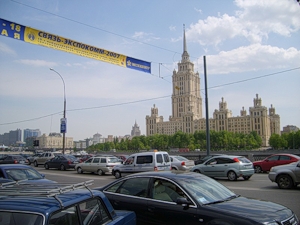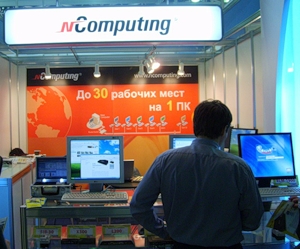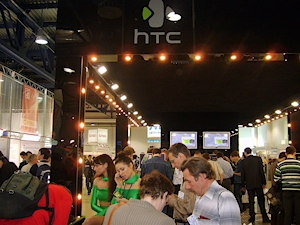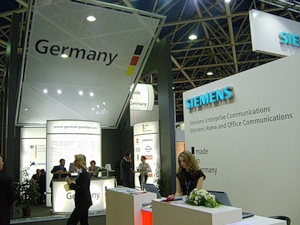Sviaz-Expocomm-2007: everything is serious
 For the 19th time, the Moscow Expocenter hosted the largest exhibition in the CIS, Sviaz-Expocomm. Literally some three, or even two years ago, it was an Event that really determined a lot in the industry and served as a starting point for dozens and hundreds of successful undertakings. In addition, there was just fun, thanks to the tricks of marketers large and small participants. As my senior comrades told me, it was not as fun as at major European and Asian exhibitions, but the desire to comply was obvious.
For the 19th time, the Moscow Expocenter hosted the largest exhibition in the CIS, Sviaz-Expocomm. Literally some three, or even two years ago, it was an Event that really determined a lot in the industry and served as a starting point for dozens and hundreds of successful undertakings. In addition, there was just fun, thanks to the tricks of marketers large and small participants. As my senior comrades told me, it was not as fun as at major European and Asian exhibitions, but the desire to comply was obvious.So, this year there was nothing like that at Expocomm. Important presentations could be counted on the fingers, and for this it was necessary to find them among the countless stands of Chinese firms and firms. From the fun and nothing left, with the departure of all mobile operators, as well as the majority of manufacturers and sellers of consumer electronics. And the most important component, in my opinion - the feeling of being involved in something historic that the atmosphere of exhibitions of previous years gave to all present - was replaced by the stale, dusty air of the empty Forum pavilion.
 Of course, there are many arguments against turning an exhibition article into an obituary. Let's take a look at them. First, those are the most important presentations. Their authors were companies that have already successfully entered foreign markets with their products and who wish to do the same in Russia. The weight of such participants varied from recent startups developing new niches to fighters for world domination in IT. The first can be attributed, for example, the company NComputing , offering a range of solutions for "multi-user ultra-thin clients" ( UTMA in the terminology of the manufacturer).
Of course, there are many arguments against turning an exhibition article into an obituary. Let's take a look at them. First, those are the most important presentations. Their authors were companies that have already successfully entered foreign markets with their products and who wish to do the same in Russia. The weight of such participants varied from recent startups developing new niches to fighters for world domination in IT. The first can be attributed, for example, the company NComputing , offering a range of solutions for "multi-user ultra-thin clients" ( UTMA in the terminology of the manufacturer).  To the second, of course, Microsoft, which finally presented our public with the Windows Mobile 2006 platform. But for this, the Redmond residents didn’t roll out their booth and modestly sat on the decent exhibition space High Tech Computers ( HTC ), which showed several models of communicators working under this OSes
To the second, of course, Microsoft, which finally presented our public with the Windows Mobile 2006 platform. But for this, the Redmond residents didn’t roll out their booth and modestly sat on the decent exhibition space High Tech Computers ( HTC ), which showed several models of communicators working under this OSesIt was interesting to see the national exhibition areas of Germany and Italy. Siemens traditionally dominated the first one, this time without any hint of mobile phones. Representatives of BenQ, by the way, decided not to go to the exhibition. A number of specialized solutions focused mainly on telecom operators attracted rather modest attention. But, without any doubt, the presence of Siemens at ExpoComm needed more to maintain its image and status than to establish new business contacts.

 The Italians, who occupied the new pavilion of the 8th pavilion, delighted the visitors with their booth design in a single white-green-orange style. The most noticeable here was the exposition of Pirelli, which presented its (one of the best in the world) cables and equipment for broadband networks. Other companies showed WiMAX equipment, home and business security systems, antennas, components for the same wired and wireless networks, as well as accessories for consumer equipment. The serious mood of the guests from the Apennines was reinforced by the presence of a delegation from the Italian Institute for International Trade.
The Italians, who occupied the new pavilion of the 8th pavilion, delighted the visitors with their booth design in a single white-green-orange style. The most noticeable here was the exposition of Pirelli, which presented its (one of the best in the world) cables and equipment for broadband networks. Other companies showed WiMAX equipment, home and business security systems, antennas, components for the same wired and wireless networks, as well as accessories for consumer equipment. The serious mood of the guests from the Apennines was reinforced by the presence of a delegation from the Italian Institute for International Trade.')
But the most active foreigners in the exhibition were the Chinese. And it was visible even not on the huge stands of Huawei and ZTE, but on the very benches of modest OEMs of low-end electronics, which were dozens. And if the former were mostly promising 3G technologies, with an emphasis on cooperation with major operators, then these ubiquitous owners of “candle factories” didn’t shy to show frank fakes under well-known brands.
 (for example, Suny Ericssun from some CCPIT). With respect to such assertiveness of the Chinese comrades in an attempt to expand their market from an exclusively internal to the neighboring Russian, I can not help but notice that the Tsaritsyn and Mitinsky markets in the capital already today show a much more interesting range of similar products. But, if their plans come true, then this year we can expect a whole invasion of super-cheap devices to our shelves. Although, if we take into account the complete absence of any agreements with retail chains, and even more so with operators who are ready to guarantee the quality of Chinese technology with their names that are dubious yet, I would call such plans too optimistic.
(for example, Suny Ericssun from some CCPIT). With respect to such assertiveness of the Chinese comrades in an attempt to expand their market from an exclusively internal to the neighboring Russian, I can not help but notice that the Tsaritsyn and Mitinsky markets in the capital already today show a much more interesting range of similar products. But, if their plans come true, then this year we can expect a whole invasion of super-cheap devices to our shelves. Although, if we take into account the complete absence of any agreements with retail chains, and even more so with operators who are ready to guarantee the quality of Chinese technology with their names that are dubious yet, I would call such plans too optimistic. A significant part of the exhibition was allocated to the TVCh-2007 sub-exhibition devoted, as you might guess, for the time being only making the first tentative steps in Russia to the direction of high-definition television. Immediately at the entrance to the eyes, there was a stand on which televisions of several Russian manufacturers were exhibited. From time to time waves of compatriots rolled up to him and with not particularly concealed surprise they tried to connect attractive devices and the inscription “Made in Russia” to each other. Many left with a clearly reinforced patriotism, some, apparently not believing in the reality of the stand, frowned and went to neighboring Koreans.
A significant part of the exhibition was allocated to the TVCh-2007 sub-exhibition devoted, as you might guess, for the time being only making the first tentative steps in Russia to the direction of high-definition television. Immediately at the entrance to the eyes, there was a stand on which televisions of several Russian manufacturers were exhibited. From time to time waves of compatriots rolled up to him and with not particularly concealed surprise they tried to connect attractive devices and the inscription “Made in Russia” to each other. Many left with a clearly reinforced patriotism, some, apparently not believing in the reality of the stand, frowned and went to neighboring Koreans. Opposite the patriotic booth, there was a black, as night, Pioneer mini-cinema, in which the company showed its own system for well-to-do home users. Outside the cinema, there was a panel that was spinning a headband about fish and a dusty, clearly blued around world Blu-ray player. Actually, it was the first such player that I managed to touch in person, for which Pioneer thanks.
Opposite the patriotic booth, there was a black, as night, Pioneer mini-cinema, in which the company showed its own system for well-to-do home users. Outside the cinema, there was a panel that was spinning a headband about fish and a dusty, clearly blued around world Blu-ray player. Actually, it was the first such player that I managed to touch in person, for which Pioneer thanks.The pavilion in which everything was supposed to be devoted to the GLONASS system caused me great interest in advance. But, having made a pair of loops on it, I could not see there something for which I could be hooked in the story, except for the names of well-known institutes and design offices widely known in narrow circles. I am inclined to leave this fact on the conscience of the organizers who failed to draw due attention to a topic that could well become central.
So, the overall picture of the exhibition, I hope, is more or less clear. Let us now return to the question whether Expocomu may or may not be a significant event in the industry in the future. There is no doubt that this year everything was done to lose such status. What is worth only the view of the Forum’s busiest pavilion in the past, in which this time there was no one: in the last days before the exhibition, many central participants turned down their representative offices. The division of the exhibition into separate parts is a sound idea and it may well develop and lead to the disintegration of the AOC into a number of specialized exhibitions of a CSTB scale or less. Perhaps this will be the best way out. But in any case, in the format in which it exists now, it has outlived itself, which could and should have been understood last year. The reasons for this phenomenon can be talked about for a long time, but this is another story.
Source: https://habr.com/ru/post/8660/
All Articles